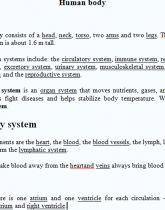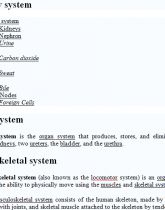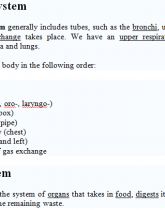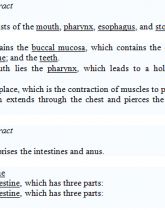Studijní materiál: Human body (Circulatory system, Respiratory system, Diges...
Skrýt detaily | Oblíbený- Kvalita:82,3 %
- Typ:Studijní materiál
- Univerzita:Veterinární a farmaceutická univerzita Brno
- Fakulta:Farmaceutická fakulta
- Kategorie:Přírodní vědy
- Podkategorie:Zdravotnictví, lékařství
- Předmět:Zdravotnictví
- Autor:stefan.potocky
- Ročník:3. ročník
- Rozsah A4:3 strán
- Zobrazeno:754 x
- Stažené:0 x
- Velikost:0,1 MB
- Formát a přípona:MS Office Word (.doc)
- Jazyk:anglický
- ID projektu:5006
- Poslední úprava:09.02.2015
The human body consists of a head, neck, torso, two arms and two legs. The average height of an adult human is about 1.6 m tall.
The body's organ systems include: the circulatory system, immune system, respiratory system, digestive system, excretory system, urinary system, musculoskeletal system, nervous system, endocrine system and the reproductive system.
The circulatory system is an organ system that moves nutrients, gases, and wastes to and from cells, helps fight diseases and helps stabilize body temperature. We have a closed circulatory system.
Circulatory system
The main components are the heart, the blood, the blood vessels, the lymph, lymph nodes, and lymph vessels form the lymphatic system.
Arteries always take blood away from the heartand veins always bring blood back.
Heart
In the heart there is one atrium and one ventricle for each circulation - left atrium, left ventricle, right atrium and right ventricle.
Respiratory system
The respiratory system generally includes tubes, such as the bronchi, used to carry air to the lungs, where gas exchange takes place. We have an upper respiratory tract and lower respiratory tract trachea and lungs.
Air moves through the body in the following order:
• Nostrils
• Nasal cavity
• Pharynx (naso-, oro-, laryngo-)
• Larynx (voice box)
• Trachea (wind pipe)
• Thoracic cavity (chest)
• Bronchi (right and left)
• Alveoli (site of gas exchange
The body's organ systems include: the circulatory system, immune system, respiratory system, digestive system, excretory system, urinary system, musculoskeletal system, nervous system, endocrine system and the reproductive system.
The circulatory system is an organ system that moves nutrients, gases, and wastes to and from cells, helps fight diseases and helps stabilize body temperature. We have a closed circulatory system.
Circulatory system
The main components are the heart, the blood, the blood vessels, the lymph, lymph nodes, and lymph vessels form the lymphatic system.
Arteries always take blood away from the heartand veins always bring blood back.
Heart
In the heart there is one atrium and one ventricle for each circulation - left atrium, left ventricle, right atrium and right ventricle.
Respiratory system
The respiratory system generally includes tubes, such as the bronchi, used to carry air to the lungs, where gas exchange takes place. We have an upper respiratory tract and lower respiratory tract trachea and lungs.
Air moves through the body in the following order:
• Nostrils
• Nasal cavity
• Pharynx (naso-, oro-, laryngo-)
• Larynx (voice box)
• Trachea (wind pipe)
• Thoracic cavity (chest)
• Bronchi (right and left)
• Alveoli (site of gas exchange




